Dyspraxia, one of those conditions that is little-known and generally quite maligned. It’s a word I only discovered relatively recently, when on my Hike Across Great Britain, I was chatting with one of my hiking partner Becky’s friends about my trials and tribulations both on the hike and in general, and she wondered if I was. I didn’t know, but when I did some research on it a few days later and told Becky what the symptoms were, she burst into laughter at the third and said to me I probably didn’t need to read any further.
Since then I’ve been looking at specific aspects of my life, both in the past and how I act now, and it’s amazing just how, just like my asexuality, all the clues were there.
What is dyspraxia?
Dyspraxia (derived from the Greek ‘ill/bad activity’) is the shorthand for a condition known as “Developmental Coordination Disorder” (DCD). Simply put, it’s a condition where the messages sent by the brain to the rest of the body – especially with regard to information around location and movement (known as ‘motor functions’) – are (in computer parlance) sometimes ‘corrupted’. A bit like seeing a pixellated image rather than a high-res one. It’s believed that around 5-6% of the population are affected by it, though as it’s commonly only picked up in childhood that figure might be higher.
The upshot of this is the dyspraxic often has issues defining their place in spacetime – we lack much spacial awareness. Which is a very fancy way of saying they bump into things. And that’s often as far as people assume dyspraxia goes – in fact one word often used to dismiss dyspraxia is ‘clumsiness’.
Is dyspraxia just being clumsy?
Absolutely not. Or at least, being clumsy is just one of the symptoms, albeit often the most apparent one.
See, dyspraxia manifests in many ways, mostly to do with spacial awareness. The reason we’re deemed as ‘clumsy’ is because we genuinely can’t judge where things are, or how big they are. For example, if there’s a small raised kerb on the roadside, there’s a fair chance we just won’t notice it, or assume it’s smaller than it really is, and therefore don’t give ourselves enough height to step over it. If there’s something at the edge of our sight and we turn around, there’s a fair chance we’ll collide with it because it’s not quite where we think it is – or rather, somewhere between our brain, our eyes, and our body, information about its location (or, indeed, our own location) gets muddled or lost, so we just don’t ‘see’ it until we hit it.
Another major motor issue we have that often comes across as ‘clumsiness’ is a lack of balance, so we seem to fall over a lot more or have trouble with some deemed-simple tasks that most people find simple, as easy as …
What do dyspraxic people struggle with?
… riding a bike!

I think this was taken in 2013. The last time I sat on a bicycle, on my own, for more than a photo-shoot.
As dyspraxia concerns motor functions, pretty much anything that involves movement is something we struggle with, to a greater or lesser degree. For me, personally, with hindsight anyway, dyspraxia is the prime reason I can neither drive nor ride a bike. The latter is largely a combination of not being able to balance properly on it, coupled with my brain not being able to register how to move my feet on the pedals at the same time. A friend of mine tried to teach me to ride a bike a few years back, as I said it would be really useful for me to learn for while I was travelling – you know, hiring a bike to go exploring around the local area or large historic sites etc. After forty minutes she had to give up because she was laughing too much. You can see a theme developing here. And to be honest, I kind of have to laugh along with it, otherwise it would frustrate me immensely.
The former, driving, though, is a lot more serious. I took driving lessons in my mid-20s, at the behest of my then girlfriend, but I found them really difficult. In total I must have had maybe 40 or 50; I was close to being put forward for my driving test but I just realised I wasn’t confident I was … safe? There was one incident I remember where I looked in my mirrors to pull out onto a major road, saw nothing coming, so moved. And nearly hit a car in that lane which, as far as my brain was concerned, had materialised out of nowhere. Another time I was waiting in a filter lane to turn right, crossing traffic, and it took me far longer than it needed to because I couldn’t easily judge how fast the cars coming at me were going, or how far away they were, so I stayed waiting until the road was free. Despite the fact I could see quite a long way down the road. I didn’t realise it then, but both those issues are classic dyspraxia.
I mentioned earlier about ‘clumsiness’. Issues I’ve had because I can’t judge where things are include many scrapes, burns, and of course several broken toes. You would have thought my preference for being barefoot would ensure I concentrate on what I’m doing and where I’m stepping, and you’d have thought incorrectly. I have caught my big toes in the opposite hem of my trousers on many occasions, which causes me to fall over (and why I like capri-length pants these days), I have bashed my little toes on shopping trolley wheels more times than I care to remember, and of course there’s both the ‘ripped toenail’ incident on my Big Hike and the ‘bent toe’ incident when hiking on Kinder Scout. The former was caused because I couldn’t judge where my foot landed on the ground while running with a backpack, so scraped it along the pavement, while the latter was me walking down a farm path some distance from the stiff grass verge on either side, but evidently not quite as far a distance as I thought. And I was walking quite quick. I could *see* the resulting bend as it was forced in the wrong direction. Obviously I didn’t go to the doctor to get it checked out. That all said, when I was a cross-country runner at school (and wore running shoes; my barefoot running experimentation came later), I was always very wary of tripping over my own shoelaces. They weren’t things I was good at tying anyway (like my school ties, which had to be ready-tied so all I needed do was pull them over my head and tighten them), and they got in the way more than thrice.
Equally though, on the Big Hike, I managed to burn my fingers on my camping stove more than twice, and sliced my thumb open with a very sharp knife in an AirBnB, even after pointing it out to Becky, who, of all people, telling me ‘oh don’t worry you won’t cut yourself on it’.
Whether wearing footwear or not, I have problems going down hills, which is awkward as an avid hiker. My problem is I’m over-conscious of my ability to trip over my own feet, or putting them in the wrong place and slipping, or just generally being a victim of gravity. This means I go down very slowly (stop sniggering) and carefully, often pausing for a while before I find a suitable place (mentally as much as physically) to put a foot. I’m particularly wary of scree slopes (common on footpaths) and cobblestones, the latter especially after rain, although I’m prone to falling over even on flat footpaths. One recent one on the way back from Glasgow city centre with a full and heavy backpack involved me tripping over either my own trousers or a very small object in the pavement used to hold signposts. Either way I ended up on the ground, half in the road, unable to get up because the backpack weighed a little over 20kg, and unable to take it off because the strap was under my body. With help from Laura, my walking companion at the time, I managed to get up without any lasting harm; I wasn’t hurt, just a slight graze on the arm, but was somewhat embarrassed.
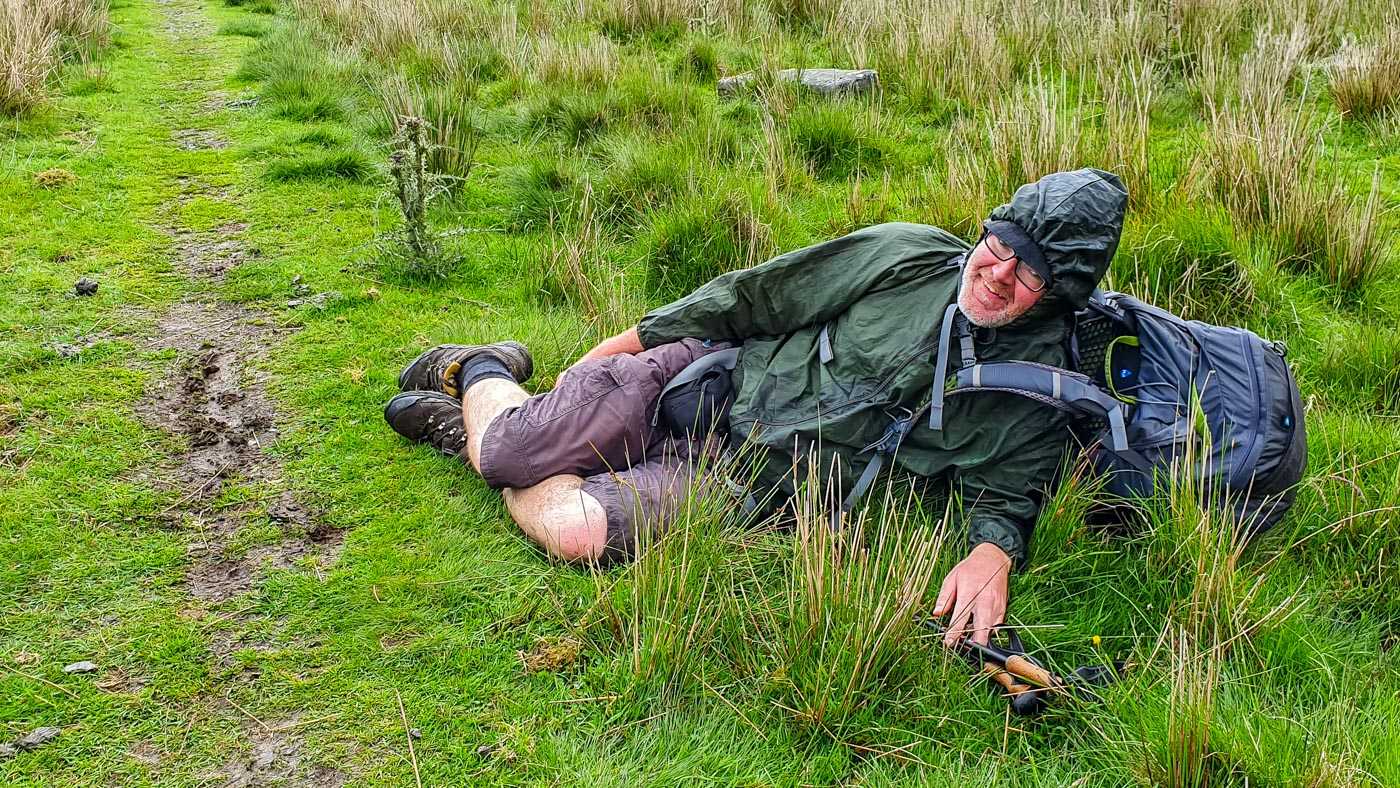
On the Pennine Way at Chelburn Moor, near Littleborough. I seem to have fallen over, for no discernible reason other than being top-heavy and ‘clumsy’.
We also have trouble following directions for things like dance moves or building furniture, in my case especially if those instructions are drawings on paper. I have to watch someone do them first, and even then slowly, and repeatedly, until they work for me. Unfortunately my probable ADHD means I find it hard to concentrate long enough when I have to do this, so I end up giving up. Case in point: the first time I put up my new camping tent in preparation for my Big Hike was a complete disaster. In addition, there’s a festival I often volunteer at that has dance workshops, everything from Charleston to Zumba, Bollywood to Capoeira. The only one I found that I had any capability for was Bollywood, because it was the only one that didn’t involve too many quick and sudden movements; I had time to process what was going on and ‘see’ where all my limbs needed to go. As a side note, this all also has implications in other aspects of my life, including an inability to wield rope.
Many people with dyspraxia have terrible handwriting. I’m on record as saying there’s no point in learning cursive writing outside of artistic endeavour, because it’s illogical to have writing that takes time to process and read. I wonder how much of that is my own dyspraxia not being able to distinguish where the letters are; certainly when I write I have to do so in printed letters because otherwise it’s completely illegible (as opposed to partially illegible – giving me blank paper is a recipe for slanted sentences. This was the case even growing up – the teachers at my primary school gave up insisting I wrote in cursive when faced with it. And obviously classic art is out of the question.
Another issue I had at school that, with hindsight, should have been an indicator of dyspraxia was during maths lessons. Now, mathematics was one of my better subjects, but I never managed to get a handle on geometry. This includes things like rotation and reflection of shapes, but also creating/building them from drawings. For instance, those ‘here’s a skeleton of a cube drawn on this piece of paper, and here’s a line on one of the squares that make the cube up. What square does the line go on to if the cube was built?’ type questions. I have to physically build the cube to answer that; I cannot visualise the shape in three dimensions. It’s the same with any kind of layout – I find it hard to ‘see’ in my mind what something looks like for real if it’s drawn. Indeed even in the real world I find it hard to judge where anything is if I can’t see it, including the layout of my own flat. I had to physically walk through my house and stand at various points to work out what was the other side of my bedroom walls because I couldn’t do it in my head. Even then I still have trouble working out how each room faces in the direction it does without literally being in it. And I’ve no chance with visualising the neighbouring flats. I don’t have ‘vision’ to create and manipulate objects in 3-dimensions in my mind.
There’s also the issue with sports. I can run, but that’s about it. I have trouble doing any sport that requires any degree of co-ordination. I mean, I can catch a ball, sure, and I can kick one, but that’s about my limit. I can’t easily judge *where* I’m hitting/kicking a ball, nor how far I need to make it go. And if I have to do something more complicated than simply releasing it, I kind of fall apart; pretty much anything from javelin to cricket, field hockey to table tennis. It’s fun for the audience to watch, at least. And of course even running events have to be flat – I tried the 3,000m steeplechase a couple of times at school, but had to stop and step over every barrier because I simply couldn’t judge its height to jump it. That said, in one of the races I still finished third out of five, a lap behind second and a lap ahead of fourth. It was a very niche event.
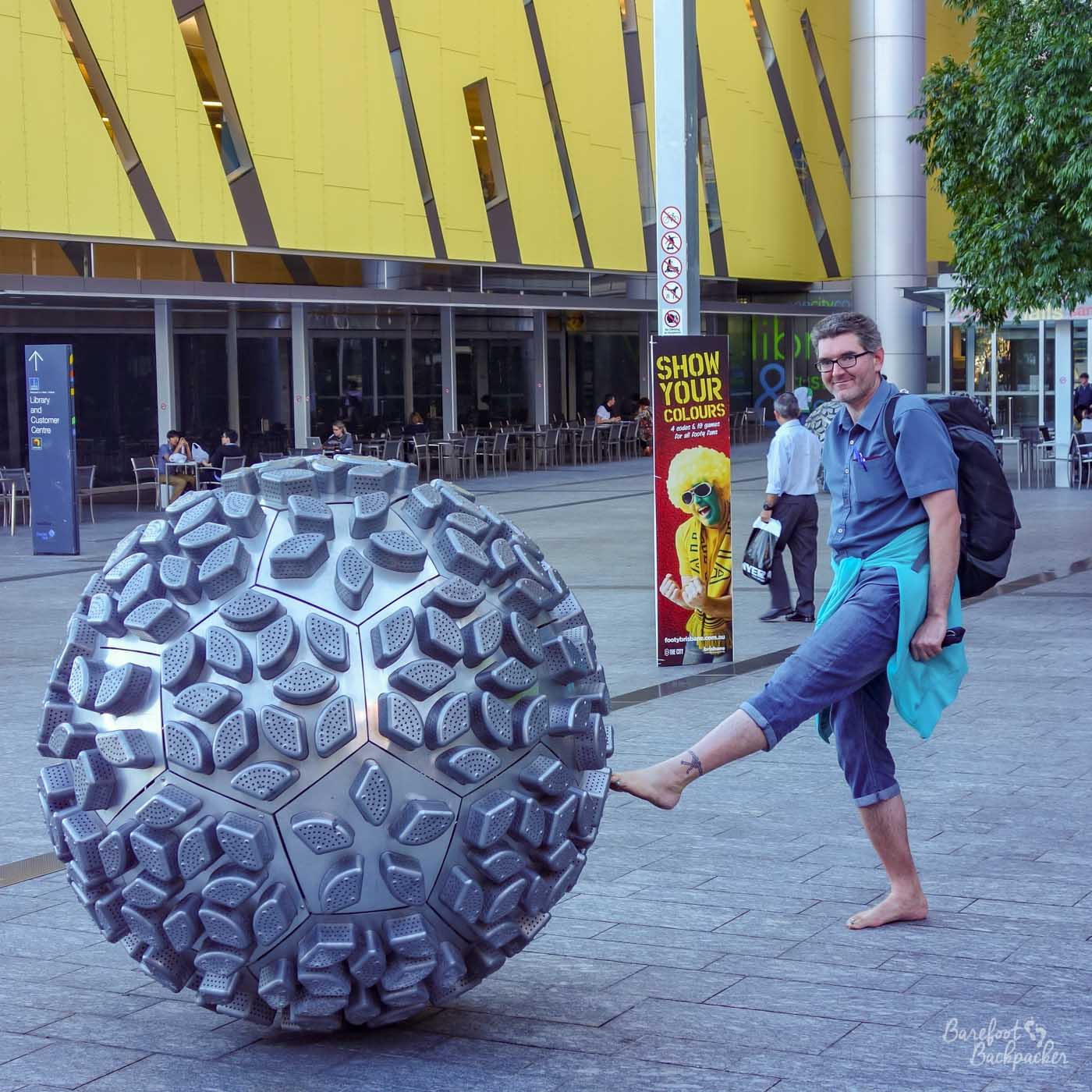
It’s only with a ball this size that I feel confident that I could make decent contact with it. It’s a piece of street artwork in Brisbane; the pic is taken in 2014 and is therefore not representative of the SARS-CoV-2 virus.
Can Adults get Dyspraxia? Isn’t Dyspraxia just a childhood condition?
Dyspraxia is usually identified in childhood, and certainly many of the resources available, both online and in person, are directed towards adults with potentially dyspraxic children. However, despite how it may seem in everyday life, dyspraxia isn’t something that people ‘grow out of’. The brain doesn’t suddenly ‘kick into gear’ in late puberty; you don’t suddenly wake up one morning at the age of 17 and find you can pick up your phone from the bedside table without having to worry about knocking over your drink.
Rather, the more you grow, both mentally and physically, the more you develop coping mechanisms that either mitigate or mask the symptoms of dyspraxia. You don’t ‘stop’ being dyspraxic, you just find ways to ‘hide’ it from view. You take more care with your movements, you don’t put yourself into a position where it becomes a problem, you avoid certain activities – I’ll talk more about this later.
Equally though, it’s unusual to develop dyspraxia as an adult. It’s likely that the symptoms were there, you just might not have noticed them at the time. Like with riding a bike – most of my schoolfriends had no issues riding bikes around the place; I didn’t realise I couldn’t because I never tried, instead preferring to stay at home on my computer. It is true I had problems in PE lessons – I never ever got the hang of skipping rope – but at the time I just thought it was something I couldn’t do, rather than it being symptomatic of a wider condition. I grew up in Liverpool and everyone played football (soccer). I was never very good at it in playground games and was always the last to be picked because (with hindsight) it’s a sport that requires thinking about distance, direction, and motor control, all things a dyspraxic has issues with. I just thought I was useless at football.
How do you know if you have dyspraxia?
The most usual way to know if you have dyspraxia is to be diagnosed with it as a child. This requires you having open-minded parents, and for you not to have been born in the 1970s.
I’ve never been officially diagnosed with it, for the same reasons I’ve never been officially diagnosed with ADHD – because they’re both commonly seen as ‘childhood’ issues, and it just would feel personally weird for me to walk into a doctor’s office and ask for a test. In addition, I’d imagine the time taken for diagnosis would be huge, or, going private, the cost would be possibly not worth the diagnosis? And as I say, that there’s no medication or ‘cure’ for it means it would just feel an awful lot of time/money to tell me something I already know.
Failing that. It’s simply a case of assessing the common signs/symptoms, and assessing not just how many of them you can provide examples of throughout your life, but also how strongly and often they occur, and whether they actively hinder or even prevent you from doing everyday activities. Everyone has their ‘clumsy’ moments; it’s when those moments are common and/or severe enough to cause a change in your lifestyle, and where there’s no other obvious cause, that you’re probably dyspraxic.
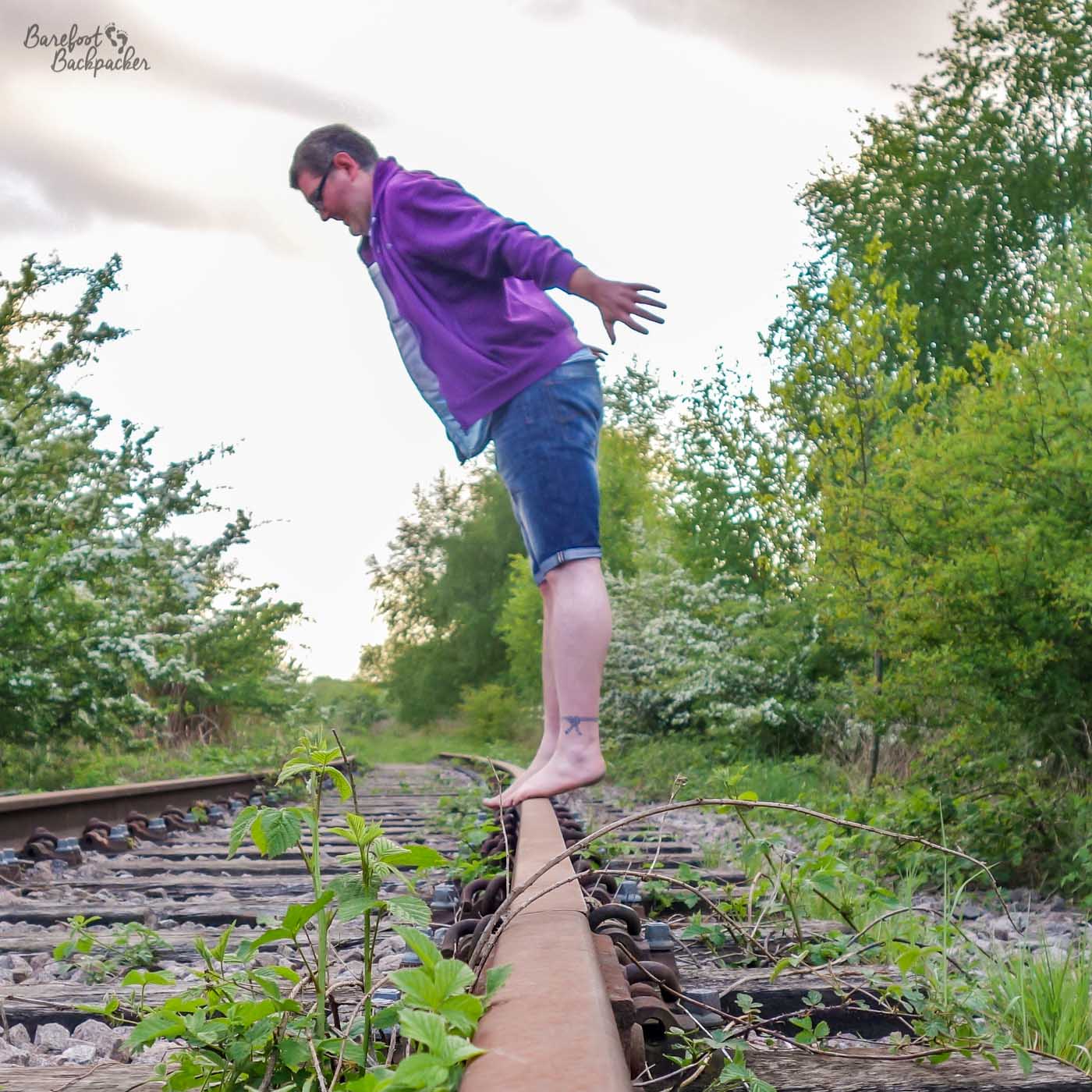
All the cool kids have a stylish pic of them standing on a railway line. This was my attempt. One of … over ten. Because balance issues while waiting for the camera timer.
Is dyspraxia a form of ADHD?
Dyspraxia is not a form of ADHD. Having said which, there is a huge overlap in the conditions, and many of the ways dyspraxia displays itself are also present in many aspects of ADHD. Examples include issues with following directions, apparent clumsiness, bad posture, and the need for reminders to prevent incidents. While the cause of these issues might be different (inattentiveness or an inability to be still, as opposed to spacial awareness issues), the effect is the same.
In addition, it’s believed that up to 50% of dyspraxics also have ADHD. Partly because they manifest in similar ways, but also because there’s a huge co-morbity in neurodiversity conditions in general – a significant proportion of people with dyspraxia are also diagnosed with dyslexia, dyscalculia, and of course autism.
I talk a bit about the overlap of dyspraxia and ADHD on Episode 46 of my podcast.
How can I deal with dyspraxia?
Unlike other aspects of neurodiversity (most notably ADHD), dyspraxia isn’t something you can deal with through medication. There isn’t a magic pill that suddenly gives you a +4 to perception.
Having probably been dyspraxic all my life, I’ve developed ‘masking’ strategies to deal with it. These include having to concentrate very hard when doing something requiring careful movement. The trouble is this tends to make me more tired and irritable, so I enjoy it less. I’ve had this happen a couple of times when hiking, when a combination of terrain and weather has meant I’ve had to think so hard about each footstep that I’ve not liked the hike itself.
When communicating, I prefer to type than write. Even in the 1990s when I had many penpals, I had a tendency to type my letters on my computer rather than write them out my hand. Partly this was because I type quicker than I write, but a large part of it was because I knew my writing wasn’t particularly legible, and writing for long periods also hurt the muscle on my palm, just below my thumb. My research into dyspraxia also suggests that people with the condition tend to hold their pens ‘incorrectly’, something I was always pulled up for at school; this may be related.
Most of the time though, my strategies for dealing with dyspraxia are to avoid situations where issues might occur – for example not driving/cycling, nor putting myself into situations where I’m reliant on movement or following pictorial instructions for the safety of myself or others – I’m very scared of the duties of being in the exit row seats on aeroplanes, even though I try to take them wherever possible for the legroom. It’s also about making sure I have enough space around me to move comfortably without fear of impacts, although I’m not at the stage yet of covering my table legs with padding. You might be more responsible. I also avoid using dangerous implements, and I get other people to, eg, do my DIY (my friends know better than to let me use power tools, especially saws and drills).
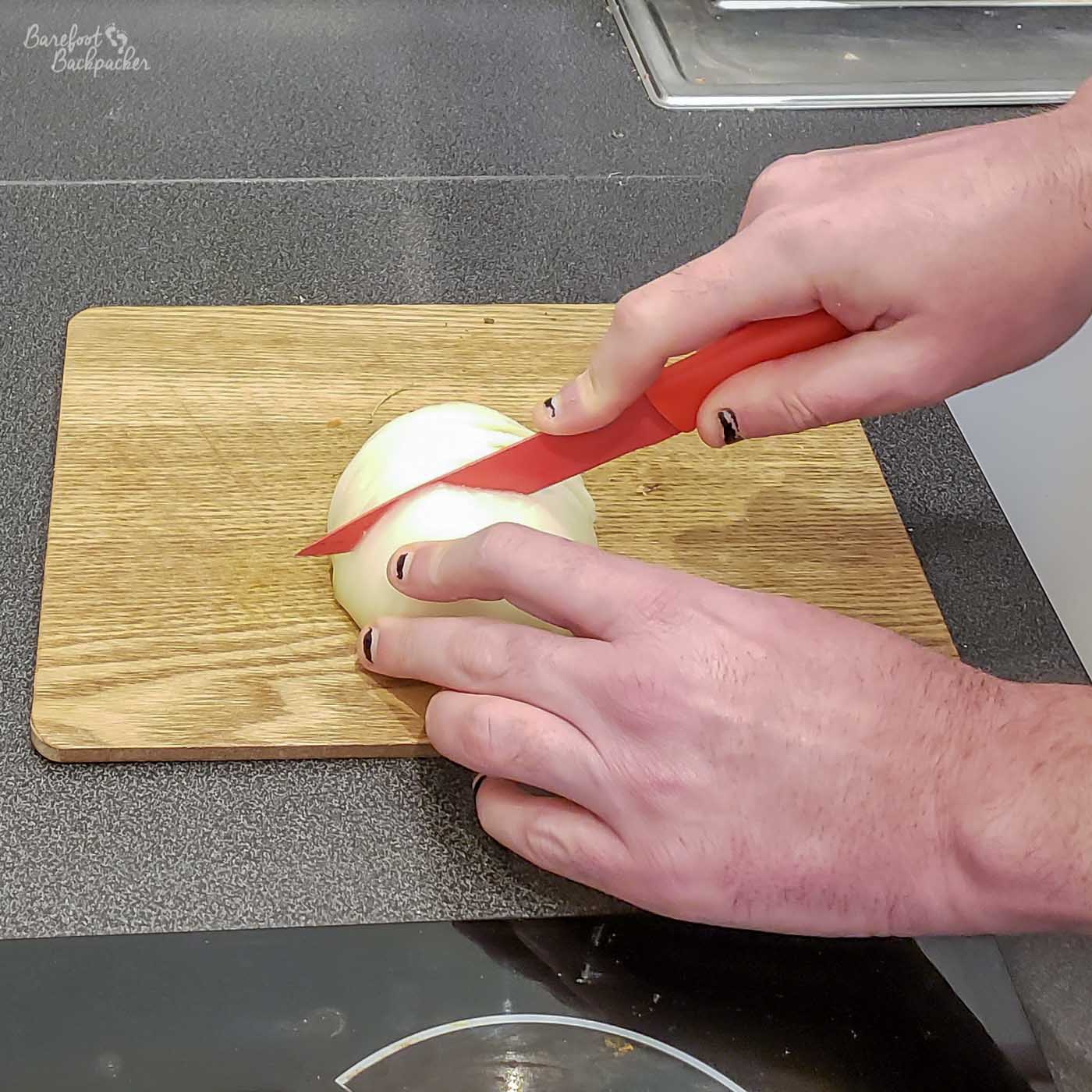
Here I am successfully chopping an onion, without chopping myself. I’m impressed. Becky would be impressed too if she saw this. This is the limit I’m prepared to go with sharp objects.
You’d have thought wearing shoes would be a good way to prevent many dyspraxia-related incidents. You’d be right.
Conclusion
Dyspraxia is a condition that affects movement and spacial awareness, and whose symptoms have a knock-on effect in everyday life. It is a disability in terms of it affects your ‘ability’ to do things, but as with many of these conditions, knowledge is power, and an awareness of what you’re capable and not capable of is a great first step to managing it. It’s not something to be scared of, and while there’s no ‘magic pill’ you can take to keep it under control, it’s fairly easy to deal with.
It’s a part of who I am, and I’ve learned the best way of coping is to treat it with good humour, to make jokes about it, to take ownership of it as it were. It’s something I’m always aware of, but I don’t let it stop me doing the things I like to do, you know, like hiking barefoot over Kinder Scout. I’m just acutely aware of the dangers it brings.
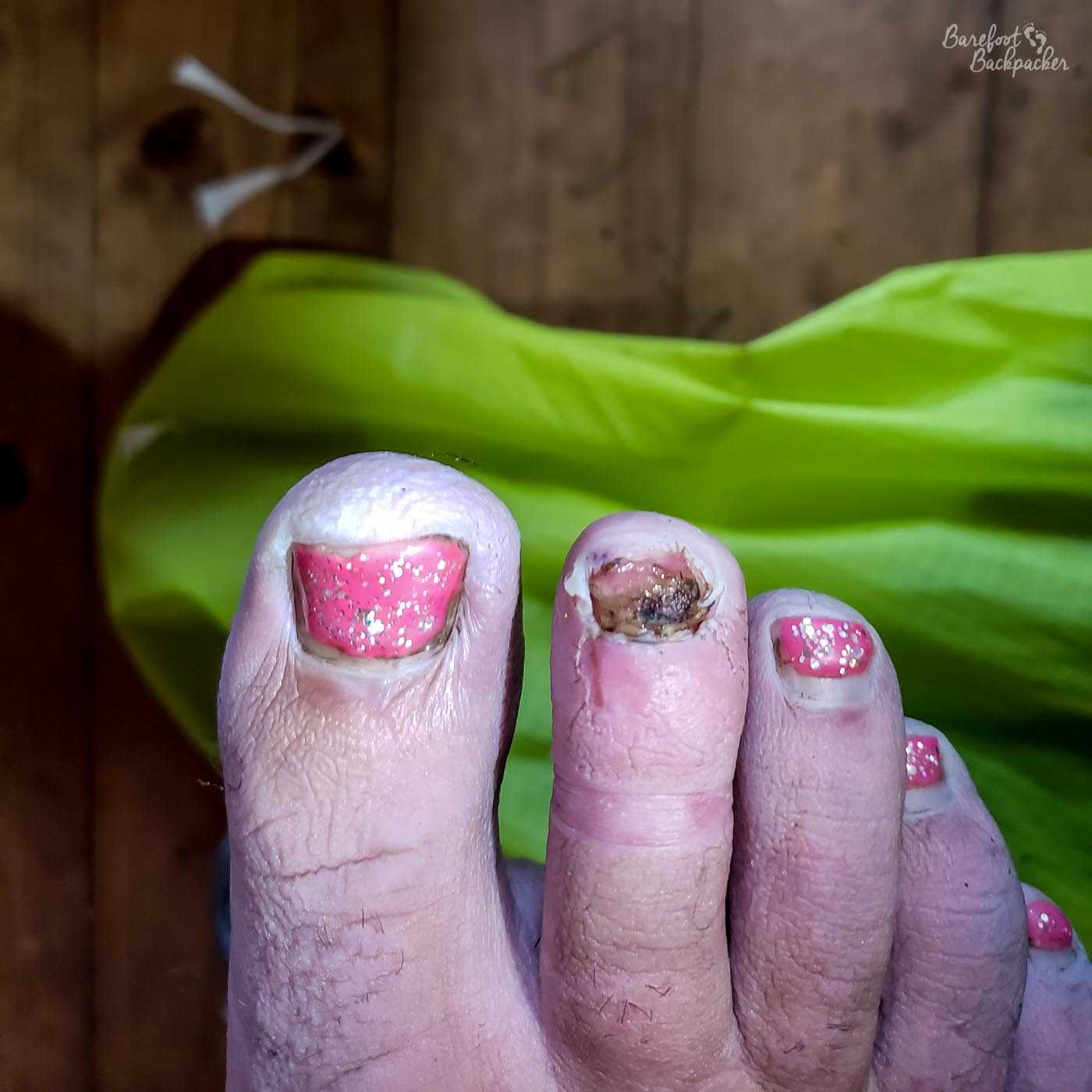
A toenail-less toe. This is the damage that being dyspraxic can yield.